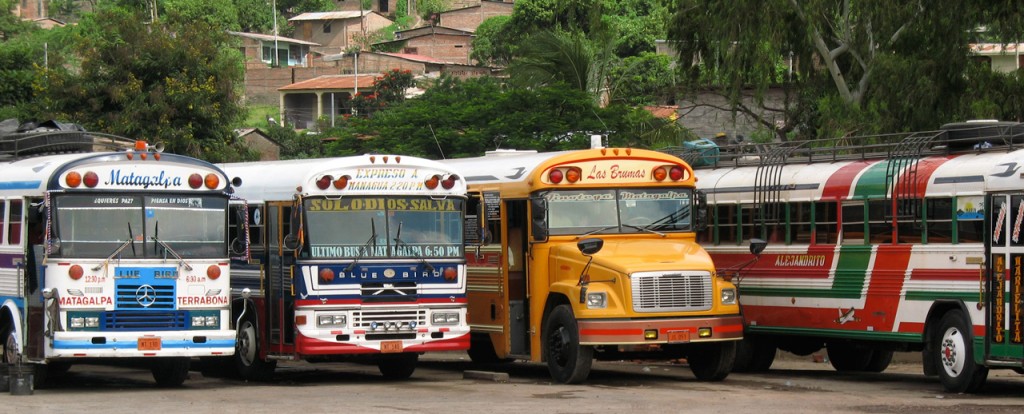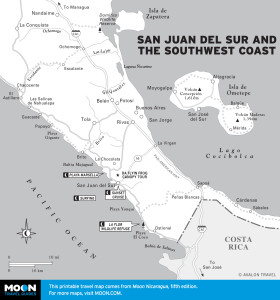Peñas Blancas is the official border crossing into Costa Rica. A major effort is underway, with financing from the United States, to make this border crossing a bottleneck and entrapment point for drug traffickers headed north. Many of the buildings you see in the compound are inspection points for the hundreds of tractor-trailers that cross the border every day. Needless to say, this is one place you don’t want to be caught smuggling furs. Sniffing dogs are common.

For the confident traveler, Nicaraguan buses leave the market in Rivas every 30–45 minutes.
Photo by StevesWorldOfPhotos licensed Creative Commons Attribution No-Derivatives.
Border hassles can last anywhere from 1–10 hours! The longest waits happen at times when the hundreds of thousands of Nicaraguans living across the border are traveling to and from their country—this happens a week before and after Christmas, Easter, and any Nicaraguan election.
The best time of day to cross is during early evening; usually you can squeeze through in under an hour.
The border is open 6 a.m.–10 p.m. Monday–Saturday; on Sunday it closes at 8 p.m. There is a fee for exiting ($2–5) and entering ($10–13) Nicaragua.
Inside the customs and immigration compound, find a branch of Bancentro, which can help you change money if necessary. Its schedule is generally tied to that of the border post itself.
Just a passport and some cash is all that’s required of North American and European travelers, but don’t forget to get stamped on both sides of the border to avoid subsequent headaches! To enter Costa Rica, Nicaraguan citizens must have a Costa Rican visa from the consulate either in Rivas or Managua. Upon entering Nicaragua, most North American and European travelers are granted a 90-day visa, with the exception of Canadian and Japanese citizens, who for some reason are given only 30 days.
By law, folks entering Costa Rica must have a ticket to leave the country. They usually don’t check, as long as you’re dressed like you have money. If they do check, you lose your place in line and go to the table outside, where Transportes Deldu will sell you an open-ended ticket from San José to Peñas Blanca for $11.
If you are driving your own vehicle, the process to enter Nicaragua from Costa Rica is lengthy but usually not too difficult (rental vehicles cannot cross the border). You’ll present your title (Titulo de la Propiedad), as well as your driver’s license and passport, and will pay a $17 vehicle entry fee. Get proper stamps from Hacienda (Timbres de Hacienda), and a property certificate from Hacienda. Also make sure you have a current tag and Tico insurance; all of this can be taken care of in the town of Liberia, just to the south.
You will be given a temporary (30-day) permit to drive in Nicaragua that will cost $10—should you lose the permit, you will be fined $100. Travelers driving their own vehicles north from the border will be forced to pass through a dubious “sterilization process” on the Nica side, in which the exterior of the vehicle is sprayed with a mystery liquid to kill porcine and bovine diseases; it costs $1 and takes five minutes unless the line is long. Roll up the windows.

San Juan del Sur and the Southwest Coast
International bus services like TicaBus are popular ways to get across the border easily and comfortably, the best service being the new TransNica Plus, since you travel with 30 instead of 55 passengers. In many cases, the bus has a helper who collects your passports and money and waits in line for you. The disadvantage is that the bus won’t pull away from the border post until every single traveler has had their papers processed, which can be time-consuming in some cases (waits up to four hours are not unheard of).
More confident travelers like to take a Nicaraguan bus to the border, walk across to Costa Rica, and take a Costa Rican bus to San José, which is often faster. Express buses from Managua to Peñas Blancas depart Mercado Huembes at 5 a.m., 8 a.m., 9:30 a.m., and 3:30 p.m. Buses and microbuses leave the market in Rivas every 30–45 minutes. On the Costa Rican side, the last bus leaves the border bound for San José at 10 p.m. (about a six-hour ride).
After crossing the border, you’ve got two choices: Buy a ticket to San José from the TransNica booth across from customs ($10 pp); the ride takes 6–8 hours, with departures daily at 5 a.m., 7 a.m., 9 a.m. direct, 10 a.m., 1 p.m. direct. Or, get a Liberia–Pulmitan bus to Liberia ($3 pp, two hours, last bus at 5:30 p.m., 506/2256-9522). From Liberia, 14 daily buses go to San José (3–5 hours); buses leave every 20 minutes to the Nicoya Peninsula and its beaches.
Liberia, the capital of Guanacaste, is also a good base for Santa Rosa National Park (where William Walker and company were resoundingly defeated) and Rincón de la Vieja National Park, with impressive volcanoes.
In fact, Guanacaste used to belong to Nicaragua and some say it still feels connected, or at least socially and physically independent of Costa Rica proper. Many locals still have family in Nicaragua, and this is the only department with its own flag.
Excerpted from the Fifth Edition of Moon Nicaragua.